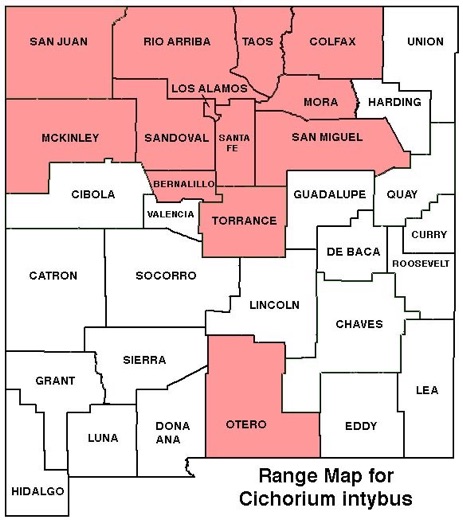WILDFLOWERS OF NEW MEXICO

Growing from a stout taproot and readily self-seeding, this European invasive thrives on roadsides and in disturbed areas in nearly every state. The erect, branching stems reach 1 1/2–3 feet tall. Note the light-blue flowers with 5 tiny teeth on each slender, petal-like ray. It has a bitter milky sap but has long been cultivated for edible fresh foliage and roots and medicinal uses. It’s closely related to endive.
FLOWER: April–October. Stemless 1–1 1/2 inch wide (25–38 mm) flowers bloom in widely-spaced clusters along branch axils or ends; flowers heads have 10–20+ light- to dark-blue, petal-like rays (no disk florets); rays flat-tipped with 5 tiny teeth; stamens showy, blue; styles twin-forked. Each flower blooms for only one day.
LEAVES: Mostly basal, alternate on stem. Rosette blades variable, oblong to elliptic, 2–13 inches long (5–35 cm); margins entire to irregularly toothed, or coarsely lobed with saw-toothed segments pointing backwards. Upper leaves much smaller, linear to lance-shaped, clasp the stem, margins toothed to entire.
HABITAT: Sandy, gravely, clay soils; roadsides, weedy, unkempt areas, disturbed places.
ELEVATION: 5,000–7,300 feet.
RANGE: Widespread throughout North America, common in nearly state.
SIMILAR SPECIES: The first year basal rosette without flowers resembles Dandelion, Taraxacum officinale.
NM COUNTIES: Common in northern NM and Sacramento Mountains (Otero County) in mid-elevation, disturbed habitats, especially roadsides: Bernalillo, Colfax, Los Alamos, McKinley, Mora, Otero, Rio Arriba, San Juan, San Miguel, Sandoval, Santa Fe, Taos, Torrance.

CHICKORY
CICHORIUM INTYBUS
Aster Family, Asteraceae
Perennial, herb; introduced, invasive


THE CONTENTS OF THIS WEBSITE ARE COPYRIGHTED AND CANNOT BE USED
WITHOUT PERMISSION OF GEORGE OXFORD MILLER
EMAIL ME


• Showy stamens are dark blue (bottom arrow).
• Styles have twin forks (top arrow).


Spike-like clusters of stemless flowers grow along erect stems. Each flower blooms only one day, follower by another bud.
Sometimes loose, open, branched clusters of flowers grow on stem ends.
